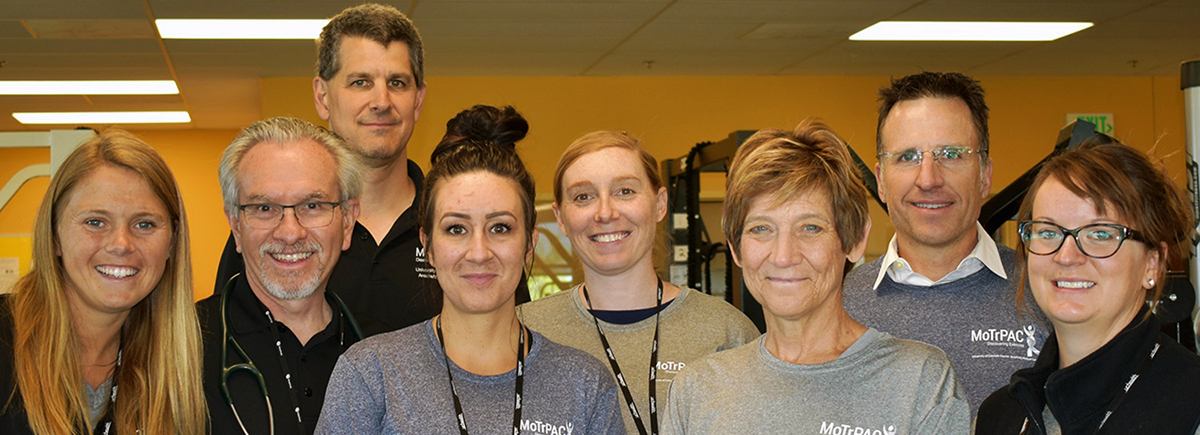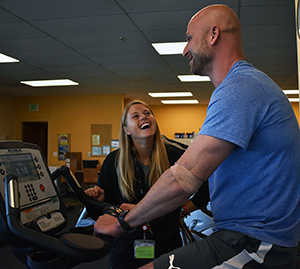
Photo by Wendy S. Meyer
Mapping Molecules
The quest for precision exercise medicine
By Wendy S. Meyer
(November 2019) This summer, Wendy Kohrt, PhD, professor of medicine in the Division of Geriatric Medicine, launched an exercise study that could be called a summer blockbuster.
It is big—involving more than 2,300 individuals across the nation— and will result in voluminous information–tens of thousands of biospecimens that will yield millions of data-points for future research.
The study is called MoTrPAC (pronounced motor-pack), which stands for Molecular Transducers of Physical Activity Consortium. Funded by the National Institutes of Health (NIH), this six-year program is the largest targeted investment into the mechanisms of how physical activity improves health and prevents disease.
“We have a lot of knowledge that exercise is good for many aspects of health,” said Kohrt. “It makes your heart and lungs healthy, your muscles and bones strong. It prevents obesity. It prevents many different health conditions and disease processes. Yet we know very little about how exercise does that—the molecular or cellular mechanisms that make exercise beneficial.”
Through MoTrPAC, researchers aim to develop a molecular map of tissue-specific and circulating signals produced by physical activity. This knowledge should allow researchers and physicians to develop individually targeted exercise recommendations for specific diseases and conditions, and better help those who are uncertain whether exercise may be as therapeutic as a medication.
“If we know, for example, that exercise turns on the same signal that a drug for diabetes turns on, we can prove exercise is a good therapeutic alternative for this process that is affected by drugs,” said Kohrt, who is also associate director of the Center for Women’s Health Research and director of the IMAGE (Investigations in Metabolism, Aging, Gender, and Exercise) research group. “This will stimulate the next wave of research to understand how exercise can be used as medicine.”
IMPACT FOR CU ANSCHUTZ
A study this large involves multiple investigators at many institutions. CU Anschutz is one of six clinical sites across the country that will be enrolling volunteers for the study. Kohrt is the principal investigator of CU’s portion of the grant, and she will be directing all of the activity in Colorado.
The study is complex not just because it involves a large number of volunteers but because of the many steps involved each time a study participant comes to the clinic for a research visit.
Kohrt’s MoTrPAC team consists of four full-time and three part-time professional research assistants, a site coordinator, an exercise supervisor, a bio-specimens manager, three physicians, two nurse practitioners, a biostatistician, a data manager, and five investigators.
Because MoTrPAC explores what happens to bodies on the molecular level before, during, and after exercise, blood and tissue samples must be taken before and after workouts. This means that a volunteer would come in and initially rest. Then a specially trained research nurse would take blood samples along with muscle and fat biopsies.
After that, the volunteer would engage in either aerobic exercise or weight lifting. The nurse would again take blood and tissue samples after the exercise. Some participants may be randomized into a group that does no exercise at all.
Professional
research assistant Claire Newman, MS, described preparations to work with hundreds of study volunteers as “hectic” and requiring “a full team effort.” Each time a volunteer comes in for a visit, he or she likely will interact
with a team of at least six people.
During its operation, MoTrPAC will rely heavily on the resources of the Colorado Clinical and Translational Sciences Institute (CCTSI) and its core laboratories, outpatient clinical and translational research clinic, and a state-of-the-art exercise research facility on the third floor of the Leprino Building on the Anschutz Medical Campus. When the Anschutz Health Sciences Building, which is currently under construction, is complete in 2021, the CCTSI and MoTrPAC will move onto the sixth floor of that building.
“We developed our comprehensive set of research resources for initiatives exactly like this one,” said CCTSI Director Ronald Sokol, MD. “We are looking forward to supporting MoTrPAC in whatever way we can.”

“Our setup is ideal,” said Kohrt. “When we had our site visit from the NIH, they were so impressed that we have a one-stop shop for everything related to this protocol, all on the same floor.”
IMPACT FOR RESEARCHERS EVERYWHERE
A distinguishing characteristic of MoTrPAC compared with other NIHfunded research is that it is a so-called exploratory study.
“In other words, we have not identified specific aims or goals,” said MoTrPAC Site Coordinator Ellie
Gibbons. “We do not have a hypothesis. We are gathering information in order to create a molecular map of tissue-specific and circulating signals produced by physical activity.
We don’t know what is going to happen, and that is what makes this different and exciting.”
MoTrPAC is also unusual in terms of the breadth of science involved. In addition to the six clinical trial sites, MoTrPAC will include:
- seven chemical analysis sites;
- three preclinical animal study sites, which will conduct physical activity studies in animal models;
- a bioinformatics center to disseminate data and tools to the entire research community; and
- a coordination center to harmonize activities across the consortium.
A novel aspect of MoTrPAC is that the information gathered will be stored in a publicly accessible database that scientists can use to study almost every organ and tissue in the human body.
“The other part of the consortium is to be a new kind of data access plan where anybody who has got a good idea about what is going to be a pretty large dataset can start to sort it through and see what we can learn about those molecules, how they work and what we can do to improve the way in which we advise people about exercise,” said Francis Collins, MD, PhD, director of NIH, when the first MoTrPAC awards were announced.
In this way, MoTrPAC will be a resource today and for years into the future for researchers everywhere. Ultimately, the research findings from this program could help scientists and clinicians define optimal physical activity recommendations for people at various stages of life. It may also allow the development of precisely targeted regimens for individuals with particular health needs.
IMPACT FOR VOLUNTEERS
This path-breaking science will depend on the participation of thousands of volunteers from across the nation.
“A study of this magnitude has never been done, which means we need a lot of research participants to help us answer our important questions,” said Renee J. Rogers, PhD, an investigator on the national MoTrPAC consortium and assistant professor at the University of Pittsburgh.
Kohrt is hoping that Colorado, with its healthy citizens and lovers of the outdoors, will be the perfect place to find volunteers. Researchers are seeking healthy individuals of all ages. They also are seeking participants who are sedentary, but who have the capacity to exercise. They will look for volunteers who routinely exercise.
Volunteers who are part of the MoTrPAC study will receive a 12-week exercise program and access to state-of-the art gym facilities. They will also receive information about their fitness level and their body composition. In addition, all volunteers will be compensated for their time.
"This is our first step into precision exercise medicine,” said Kohrt. “We are looking for people who want be on the leading edge of the wave to develop this incredible knowledge base.”
If you are interested in learning more about how to volunteer for the study, go to the MoTrPAC website.